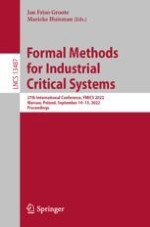2022 | Buch
Formal Methods for Industrial Critical Systems
27th International Conference, FMICS 2022, Warsaw, Poland, September 14–15, 2022, Proceedings
herausgegeben von: Prof. Jan Friso Groote, Prof. Dr. Marieke Huisman
Verlag: Springer International Publishing
Buchreihe : Lecture Notes in Computer Science
